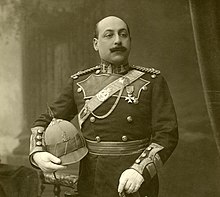Prince Frederick Victor Duleep Singh, MVO, TD, FSA (23 January 1868 – 15 August 1926),[1] also known as Prince Freddy, was a younger son of Sir Duleep Singh, the last Maharaja of the Sikh Empire.
| Frederick Duleep Singh | |
|---|---|
| Crown Prince of Punjab | |
 Prince Frederick Duleep Singh | |
| Head of the Royal House of Punjab | |
| Period | 7 July 1918 – 15 August 1926 |
| Predecessor | Victor Duleep Singh |
| Successor | None (House extinct under uterine primogeniture) |
| Born | Frederick Victor Duleep Singh 23 January 1868 London, United Kingdom |
| Died | 15 August 1926 (aged 58) Blo' Norton Hall, Diss, Norfolk, United Kingdom |
| Burial | Blo' Norton Church |
| House | Sukerchakia |
| Father | Duleep Singh |
| Mother | Bamba Müller |
| Education | |
| Military career | |
| Allegiance | |
| Service/ | British Armed Forces |
| Years of active service | 1893–1919 |
| Rank | See list |
| Unit | Suffolk Yeomanry Norfolk Yeomanry |
Early life edit
Prince Frederick was born in London as the third son (the second surviving after the oldest son died on the first day after his birth) of Sir Duleep Singh and Bamba Müller, the former Maharaja and Maharani Duleep of Lahore.
He was educated at Eton and Magdalene College, Cambridge where he read History (B.A. 1890; M.A. 1894).[2] At Cambridge, he was a member of the Pitt Club.[3]
He was deeply interested in archaeology, contributing articles to various periodicals and became a Fellow of the Society of Antiquaries. He wrote Portraits in Norfolk Houses (1929, two volumes) alongside Rev. Edmund Farrer, and with Farrer and his friend Charles Partridge compiled and published Portraits in Suffolk Houses.[4] He was East Anglia representative of the Society for the Protection of Ancient Buildings and reported on about 50 historic building cases for it.
Career edit
He lived at Old Buckenham Hall and for 20 years, at Blo' Norton Hall near Thetford. He was a staunch monarchist, possibly due to his father's good relationship with Queen Victoria, even hanging a portrait of republican Oliver Cromwell upside-down in his lavatory at Blo' Norton.[citation needed] His collection of Jacobite and Stuart relics (and the Cromwell painting) were presented to Inverness Museum. He gave to the town of Thetford the timber-framed Ancient House (now a museum) together with his collection of portraits.
Military edit
Prince Frederick served with Yeomanry regiments from 1893 to 1919.
- Appointed Second Lieutenant: – Suffolk Imperial Yeomanry – 12 August 1893.
- Promoted Lieutenant: 21 July 1894.
- Promoted Captain: 19 August 1898.[5]
In July 1901, Prince Frederick transferred to the Norfolk Yeomanry from the Suffolk Yeomanry and was promoted to the rank of major.[6] He resigned his commission in 1909 but rejoined the Norfolk Yeomanry in 1914 at the outbreak of World War I and was on active service in France for two years and with the General Staff.
Honours edit
Punjabi edit
- House of Punjab: Sovereign Knight Grand Cross of the Order of the Propitious Star of Punjab
- House of Punjab: Sovereign Knight Grand Cross of the Order of Ranjit Singh
British edit
- United Kingdom: Member of the Royal Victorian Order, 1901
- United Kingdom: Recipient of the Territorial Medal
- United Kingdom: Recipient of the 1914 Star Medal
- United Kingdom: Recipient of the Victory Medal
- United Kingdom: Recipient of the King Edward VII Coronation Medal
- United Kingdom: Recipient of the King George V Coronation Medal
Ancestry edit
| Ancestors of Frederick Duleep Singh | |||||||||||||||||||||||||||||||||||||||||||||||||||||||||||||||||||||||||||||||||||||||||||||||||||||||||||||||||||||||||||||||||||||||||||||||||||||||||||||||||||||||||||||||||||||||||||||||||||||||||||||||||||||||||||||||||||||||||||||||||||||||||||||||||||||||||
|---|---|---|---|---|---|---|---|---|---|---|---|---|---|---|---|---|---|---|---|---|---|---|---|---|---|---|---|---|---|---|---|---|---|---|---|---|---|---|---|---|---|---|---|---|---|---|---|---|---|---|---|---|---|---|---|---|---|---|---|---|---|---|---|---|---|---|---|---|---|---|---|---|---|---|---|---|---|---|---|---|---|---|---|---|---|---|---|---|---|---|---|---|---|---|---|---|---|---|---|---|---|---|---|---|---|---|---|---|---|---|---|---|---|---|---|---|---|---|---|---|---|---|---|---|---|---|---|---|---|---|---|---|---|---|---|---|---|---|---|---|---|---|---|---|---|---|---|---|---|---|---|---|---|---|---|---|---|---|---|---|---|---|---|---|---|---|---|---|---|---|---|---|---|---|---|---|---|---|---|---|---|---|---|---|---|---|---|---|---|---|---|---|---|---|---|---|---|---|---|---|---|---|---|---|---|---|---|---|---|---|---|---|---|---|---|---|---|---|---|---|---|---|---|---|---|---|---|---|---|---|---|---|---|---|---|---|---|---|---|---|---|---|---|---|---|---|---|---|---|---|---|---|---|---|---|---|---|---|---|---|---|---|---|---|---|
| |||||||||||||||||||||||||||||||||||||||||||||||||||||||||||||||||||||||||||||||||||||||||||||||||||||||||||||||||||||||||||||||||||||||||||||||||||||||||||||||||||||||||||||||||||||||||||||||||||||||||||||||||||||||||||||||||||||||||||||||||||||||||||||||||||||||||
References edit
- ^ Photo of his memorial
- ^ "Duleep-Singh, Prince Frederick Victor (DLP887PF)". A Cambridge Alumni Database. University of Cambridge.
- ^ Fletcher, Walter Morley (2011) [1935]. The University Pitt Club: 1835-1935 (First Paperback ed.). Cambridge: Cambridge University Press. p. 90. ISBN 978-1-107-60006-5.
- ^ "Collections Online | British Museum".
- ^ Service Record
- ^ "No. 27348". The London Gazette. 23 August 1901. p. 5596.